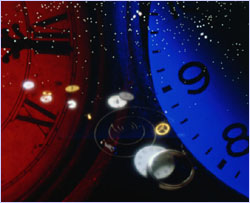
|
 |
 |
 Time Can Vary?
Time Can Vary?That's right! Contrary to what common sense tells us, time and distance are not fixed. This, too, is the assumption Einstein made. In our second and third train examples, the speed of light turns out to be exactly the same for both you and the observer standing along the tracks because time, as measured by your watch, ticked along at a slower pace than time measured by the observer. Not only that, distance changed, too. For the observer, a one-foot ruler whizzing by on the train would have measured less than a foot. The weird thing is that, for you on the train, time wouldn't seem to be moving slower and your ruler wouldn't be shorter—all would appear normal. However, time on the rest of the Earth would appear to be ticking along slower and its rulers would be shorter. Now let's say you want to do some time travelling. You board a spaceship and take off for deep space. The ship approaches the speed of light. Time for you seems to pass as it always has. It takes you about five seconds to tie your shoe. But to an observer on Earth (assuming he or she could watch you), you are moving at a snail's pace. It takes hours to tie your shoe. Anyway, you continue on your journey. You slow down, stop, and accelerate back to Earth. You arrive home. You have aged two years during your flight. Two hundred years have passed on Earth. You have successfully travelled forward through time. Now you want to go back? Sorry. According to relativity, you can only move through time in one direction. For more about time travel, visit the Time Traveller Hot Science, featured in the Einstein Revealed Web site. Sagan on Time Travel | Traveling Through Time Timespeak | Think Like Einstein | Resources Teacher's Guide | Transcript | Site Map Editor's Picks | Previous Sites | Join Us/E-mail | TV/Web Schedule About NOVA | Teachers | Site Map | Shop | Jobs | Search | To print PBS Online | NOVA Online | WGBH © | Updated November 2000 |